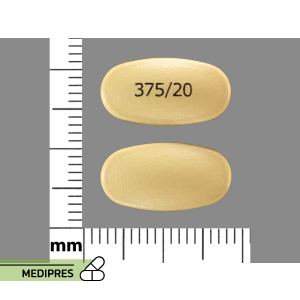
Vardenafil
23 June, 2023
Vontrol
23 June, 2023Vimovo
Generic name:
naproxen / esomeprazole magnesium
Drug class:
Nonsteroidal anti-inflammatory drug (NSAID) and proton pump inhibitor (PPI) combination
Dosage form:
Delayed-release/extended-release tablets
Root of administration:
Oral
Dose:
- 375 mg naproxen / 20 mg esomeprazole once daily
- 500 mg naproxen / 20 mg esomeprazole once daily
- Taken in the morning on an empty stomach, at least 60 minutes before food
Mechanism of action:
Naproxen inhibits cyclooxygenase-1 and cyclooxygenase-2, reducing prostaglandin synthesis for anti-inflammatory, analgesic, and antipyretic effects. Esomeprazole irreversibly inhibits the H+/K+-ATPase in gastric parietal cells, suppressing gastric acid secretion to protect the gastrointestinal mucosa.
Drug usage cases:
- Osteoarthritis
- Rheumatoid arthritis
- Ankylosing spondylitis
- Reduction of risk of NSAID-associated gastric ulcers in at-risk patients
- Off-label: Gout flares
- Off-label: Tendonitis and bursitis
- Off-label: Juvenile idiopathic arthritis
Drug contra indications:
- Hypersensitivity to naproxen, esomeprazole, aspirin, other NSAIDs, or benzimidazole agents
- History of asthma, urticaria, or allergic-type reactions after taking aspirin or other NSAIDs
- Active or suspected gastrointestinal bleeding or peptic ulcer disease
- Severe hepatic impairment (Child-Pugh C)
- Severe renal impairment (CrCl < 30 mL/min)
- Concurrent use of rilpivirine-containing products
- Patients in whom naproxen or esomeprazole are otherwise contraindicated
Side effects:
- Gastrointestinal: dyspepsia, abdominal pain, nausea, diarrhea, constipation, flatulence, GI ulceration, bleeding, perforation
- Central nervous system: headache, dizziness, somnolence
- Cardiovascular: hypertension, edema, palpitations
- Renal: increased BUN, increased serum creatinine, renal impairment
- Hepatic: elevated liver enzymes (AST/ALT), hepatitis
- Dermatologic: rash, pruritus, Stevens-Johnson syndrome, toxic epidermal necrolysis
- Hematologic: anemia, bleeding, thrombocytopenia, leukopenia
- Respiratory: dyspnea
- PPI-specific: hypomagnesemia, vitamin B12 deficiency, flatulence, abdominal pain, headache
- Other: weight gain, arthralgia, back pain
Warnings:
- Cardiovascular risk: increased risk of serious CV thrombotic events, myocardial infarction, and stroke
- Gastrointestinal risk: serious GI adverse events including bleeding, ulceration, and perforation
- Renal toxicity: risk of renal impairment, interstitial nephritis, acute renal failure
- Hepatic effects: risk of hepatic dysfunction and elevated liver enzymes
- Anaphylactic reactions: possible in patients with or without known NSAID allergy
- Serious skin reactions: exfoliative dermatitis, Stevens-Johnson syndrome, toxic epidermal necrolysis
- Masking of inflammation and fever: may diminish signs of infection
- PPI-related: Clostridium difficile-associated diarrhea, bone fracture risk, hypomagnesemia, fundic gland polyps, vitamin B12 deficiency
- Use in elderly: greater risk for GI bleeding, cardiovascular and renal adverse events
Use during pregnancy or breastfeeding:
Naproxen is pregnancy category C in the first and second trimesters and category D in the third trimester (risk of premature closure of the ductus arteriosus). Esomeprazole is pregnancy category C; use only if the potential benefit justifies the risk. Both agents are excreted in breast milk; use with caution during breastfeeding or consider alternative therapies.



